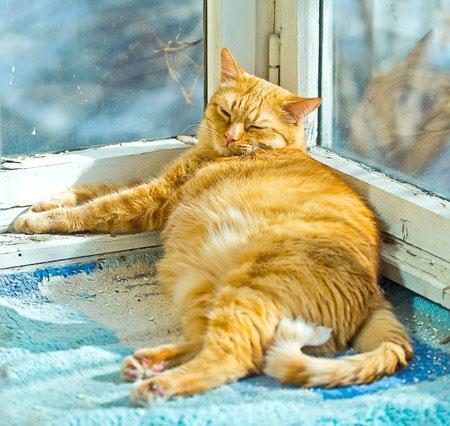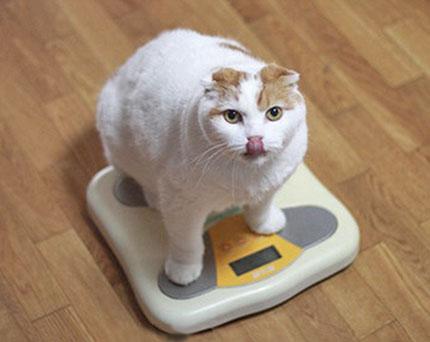This content is archived from the Feline Nutrition Foundation
Slimming Your Cat: What Works, What Doesn't
- Updated: Sunday, April 07, 2019 02:37 PM
- Published: Saturday, August 15, 2015 01:18 PM
- Written by Mark E. Peterson, DVM, Dip. ACVIM
 As in humans, obesity is a major problem in cats in this country. Unfortunately, the feline obesity epidemic appears to be getting worse, rather than better.¹ ² Many veterinarians and cat owners who have tried traditional feline weight loss diets, generally high fiber/low fat, find this approach frustrating, as it usually fails to achieve significant loss of weight. Another approach in treating and preventing feline overweight and obesity revolves around our understanding of basic feline nutritional needs and their feeding behavior.¹⁻⁷ The way we feed our cats and what we feed them tends to violate all principles of "ideal" feline nutrition.
As in humans, obesity is a major problem in cats in this country. Unfortunately, the feline obesity epidemic appears to be getting worse, rather than better.¹ ² Many veterinarians and cat owners who have tried traditional feline weight loss diets, generally high fiber/low fat, find this approach frustrating, as it usually fails to achieve significant loss of weight. Another approach in treating and preventing feline overweight and obesity revolves around our understanding of basic feline nutritional needs and their feeding behavior.¹⁻⁷ The way we feed our cats and what we feed them tends to violate all principles of "ideal" feline nutrition.
Indoor cats are commonly fed energy-dense, high-carbohydrate dry foods in a free choice manner, which provides the cat with much more energy than he or she can possibly use. Outdoor cats in the wild must maintain fitness, and therefore a lean body weight, in order to successfully hunt for food. Such fitness is not required in sedentary, indoor cats, and they take advantage of the highly-palatable food that is readily available, without any undue physical effort to sustain. Free access to plentiful amounts of cat food plus little physical activity leads to overweight and obesity in cats, as in other species.⁵⁻⁸
Obesity and the Composition of the Diet
One factor that is important to consider, both in the development of and treatment of obesity, is the role of carbohydrates in the diet – not because carbs themselves are directly associated with fat, although excess carbs are stored as fat – but because of the effect on protein levels in the diet.
The higher the concentration of carbs in the diet, the lower the intake of protein. This can result in a lower-than-needed intake of protein for maintenance and energy. We can never forget that cats are evolutionarily designed to use protein and fat preferentially as energy sources.³ ⁴ Cats have absolutely no requirement for any carbs in their diet.
Because of the metabolic requirement for cats to utilize protein as an energy source, diets with modest amounts of protein, with an average digestibility, can result in loss of muscle mass or sarcopenia.⁶ ⁷ ⁹⁻¹¹ The loss of lean muscle mass leads to a lowering of the metabolic rate and can make weight gain even worse.
Traditional Weight Loss Diets Lead to Muscle Wasting
 Traditional weight loss plans include feeding an energy restricted, e.g., low-fat, high-carbohydrate, high-fiber, diet. However, while these diets may result in weight loss, they do so to the detriment of lean body mass, especially as cats use protein for energy even in the face of other energy sources in the diet.
Traditional weight loss plans include feeding an energy restricted, e.g., low-fat, high-carbohydrate, high-fiber, diet. However, while these diets may result in weight loss, they do so to the detriment of lean body mass, especially as cats use protein for energy even in the face of other energy sources in the diet.
Successful weight loss regimens require loss of adipose tissue as well as maintenance of lean body mass.⁵⁻⁷ We must remember that lean body mass is the driver of basal energy metabolism. Loss of lean body mass is a major contributor to weight regain as appetite is not reduced and satiety not reached.
Feeding High-Protein, Low-Carb Diets is Best
Several recent studies have evaluated use of a high-protein, low-carbohydrate diet – protein 45% or higher – for weight loss in cats.⁵⁻⁷ ¹² ¹³ In those studies, cats lost weight but maintained lean body mass. Importantly, high-protein, low-carbohydrate canned diets not only resulted in sustained weight loss in these cats, but also helped reduce the cats' urge to eat constantly. This is simply because the cats are more likely to be satiated when feeding a canned or a raw meat diet versus a dry food with fiber.
Because dry foods must be extruded, i.e., made into a biscuit, carbohydrates are required in the cooking process. Thus, it is difficult to achieve a low-carbohydrate diet that is dry. Further, many of the available high-protein, low-carbohydrate dry foods are not low-calorie foods, so it is extremely easy to feed too much. Too many calories, including too many protein calories, will also cause weight gain or failure to lose weight, as well.⁶ ⁷ ¹⁴
At this time, the best commercial diets for achieving a high-protein, low-carbohydrate profile, along with controlled calories, are canned foods or a balanced raw meat diet. But it is important to remember that if you are feeding a canned food, it does not mean that you are feeding a high-protein, low-carbohydrate diet – you must read the label – and it also doesn't mean you are feeding a high-quality protein.
Stop Free-Choice Feeding
An important follow-up point to remember about all diets is that calories count. You cannot "free choice" feed most indoor cats, even with high-protein, low-carb diets, because if they consume too many calories, they will become or remain obese.
The daily allotment of food should be fed in multiple small meals to mimic the cat's natural feeding strategy of hunting and catching about ten small prey animals per day. This also increases the thermal effect of food, which increases the metabolic rate and assists in weight loss.
Calculating Calories for Weight Reduction in Cats
 One key point for obesity prevention or correction is balancing the energy intake/energy expenditure equation. In indoor cats, where exercise is reduced by the nature of the lifestyle, energy restriction becomes paramount to obesity prevention or correction.⁵⁻⁷ Most indoor cats do not need more than their resting energy requirement, or RER, to meet their daily nutritional requirements. This is approximately 180-200 kcal/day for a 10-11 pound cat.
One key point for obesity prevention or correction is balancing the energy intake/energy expenditure equation. In indoor cats, where exercise is reduced by the nature of the lifestyle, energy restriction becomes paramount to obesity prevention or correction.⁵⁻⁷ Most indoor cats do not need more than their resting energy requirement, or RER, to meet their daily nutritional requirements. This is approximately 180-200 kcal/day for a 10-11 pound cat.
Cats that are very obese will likely need to reduce their intake by 20% to 40%, or 60-80% of their RER, to lose weight.⁵⁻⁷ So, for a cat that is 16 pounds, about 7.5 kg, that should weigh 11 pounds, or 5 kg, it may require a reduction of calories to only 120-130 kcal/day. It is much more difficult to reduce calories using dry food than it is using canned food because of the small amount of kibble that must be fed.
The key point is this: set a target calorie intake, make sure you are feeding a high-protein food to protect muscle mass and prevent protein malnutrition, weigh the cat monthly and adjust the amount of food based on weight loss.
The Bottom Line
Energy restriction can be achieved by low-fat, high-fiber diets, but most of those diets are not high enough in protein to preserve muscle. Such loss of muscle mass results in an unhealthy weight loss and a strong tendency to regain weight, i.e., the loss of muscle mass will always increase the likelihood of rapid regain of lost weight or failure of weight loss.
Additional Reading
Answers: Why Did My Cat's Fur Get So Silky?
Answers: Plant vs. Meat – The Protein Feud for Cat Food
High-protein, low-carbohydrate, low-fat diets are ideal for weight loss in cats: they help preserve muscle mass while restricting energy sources that will induce fat loss. However, portion control is ultimately the key to controlling energy intake.
The easiest way to both feed a high-protein, low-carbohydrate diet while achieving portion control is to feed canned food or a complete, supplemented raw meat diet. In cats that won't eat canned or raw foods, there are only a few high-protein, low-fat, low-carb dry foods, but these should be selected for use in weight loss programs only when absolutely needed.
Dr Mark E. Peterson has been deeply involved in clinical research for over 35 years, and remains at the forefront of the science that advances the study and knowledge of endocrine diseases of cats. He was the first veterinarian to document hyperthyroidism in cats (1979) and the first to treat hyperthyroid cats with radioiodine (in 1980). In addition to hyperthyroidism, Dr. Peterson was the first to document a number of "new" diseases in cats, including acromegaly, hypoparathyroidism, insulinoma and Addison's disease. Dr. Peterson is director of theAnimal Endocrine Clinicin New York City, a specialty referral hospital devoted exclusively to the care of cats and dogs with endocrine disease.
1. DL Zoran, "Obesity in Dogs and Cats: A Metabolic and Endocrine Disorder," Veterinary Clinics of North America Small Animal Practice40, March 2010, no. 2, 221-239.
2. DL Zoran, CAT Buffington, "Effects of Nutritional Factors and Lifestyle Choice on the Health and Well-being of Indoor Cats," Journal of the American Veterinary Medical Association 239, Sept 2011, no. 5, 596-606.
3. DL Zoran, "The Carnivore Connection to Nutrition in Cats," Journal of the American Veterinary Medical Association 221, Dec 2002, no. 11, 1559-1567.
4. DL Zoran, "The Unique Nutritional Needs of the Cat," In: SJ Ettinger, EC Feldman (eds), Textbook of Veterinary Internal Medicine, 7th edition, Saunders Elsevier, 2010, 652-659.
5. DP Laflamme, "Understanding and Managing Obesity in Dogs and Cats," Veterinary Clinics of North America Small Animal Practice 36, Nov 2006, no. 6, 1283-1295.
6. DL Zoran, "Feline Obesity: Recognition and Management," Compendium for Continuing Education for the Practicing Veterinarian 31, June 2009, no. 6, 284-293.
7. DL Zoran, "Protein: The Key to Metabolism, Health and Management of Obesity in Cats," 2012 OVMA Conference.
8. EJ Harper, DM Stack, TD Watson, et al, "Effects of Feeding Regimens on Bodyweight, Composition and Condition Score in Cats Following Ovariohysterectomy," Journal of Small Animal Practice 42, Sep 2001, no. 9, 433-438.
9. SS Hannah and DP LaFlamme, "Effect of Dietary Protein on Nitrogen Balance and Lean Body Mass in Cats," Veterinary Clinical Nutrition, no. 3, 1996, 30.
10. G Perez-Camargo, "Cat Nutrition: What is New in the Old?," Compendium for Continuing Education for the Practicing Veterinarian 26, 2004, Supplement 2A, 5-10.
11. JJ Wakshlag, "Dietary Protein Consumption in the Healthy Aging Companion Animal," Proceedings of the Nestlé Purina Companion Animal Nutrition Summit: Focus on Gerontology, 2010, 32-39.
12. RS Vasconcellos, NC Borges, KN Goncalves, et al, "Protein Intake During Weight Loss Influences the Energy Required for Weight Loss and Maintenance in Cats," Journal of Nutrition 139, May 2009, no. 5, 855-860.
13. P Nguyen, V Leray, H Dumon, et al, "High Protein Intake Affects Lean Body Mass But Not Energy Expenditure in Nonobese Neutered Cats," Journal of Nutrition 134, Aug 2004, Supplement 8, 2084S-2086S.
14. A Wei, AJ Fascetti, KJ Liu, et al, "Influence of a High-protein Diet on Energy Balance in Obese Cats Allowed Ad Libitum Access to Food," Journal of Animal Physiology and Animal Nutrition 95, June 2011, no. 3, 359-367.




